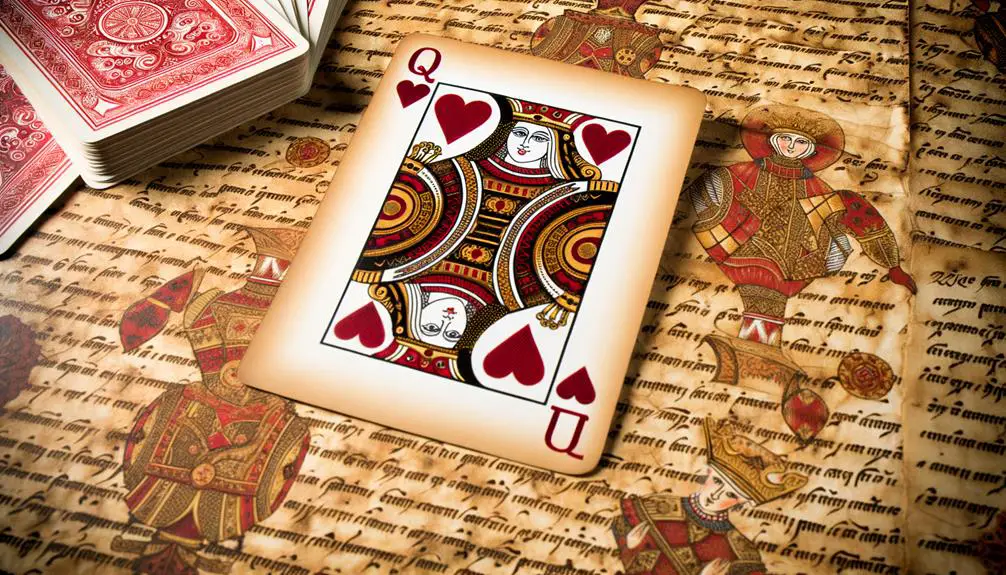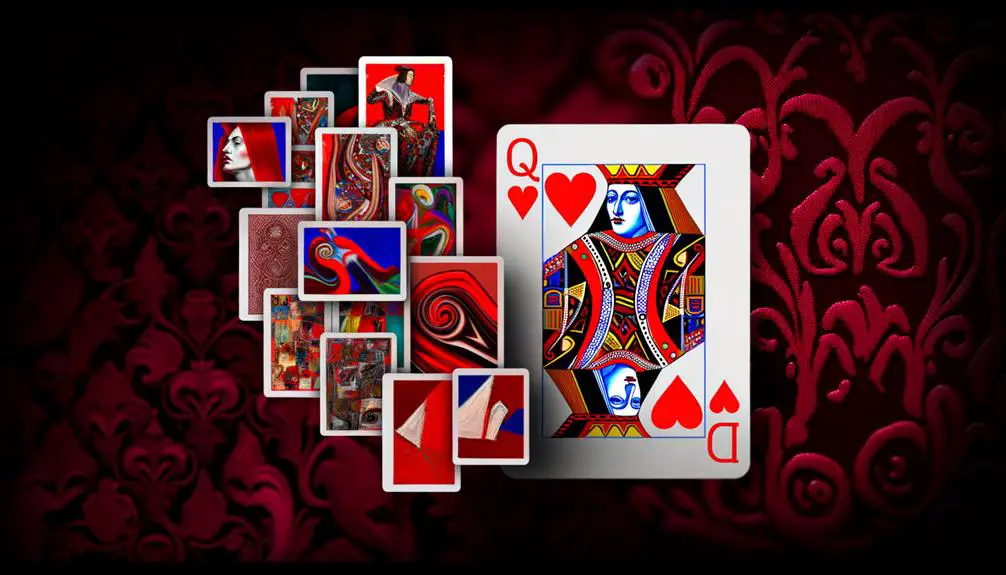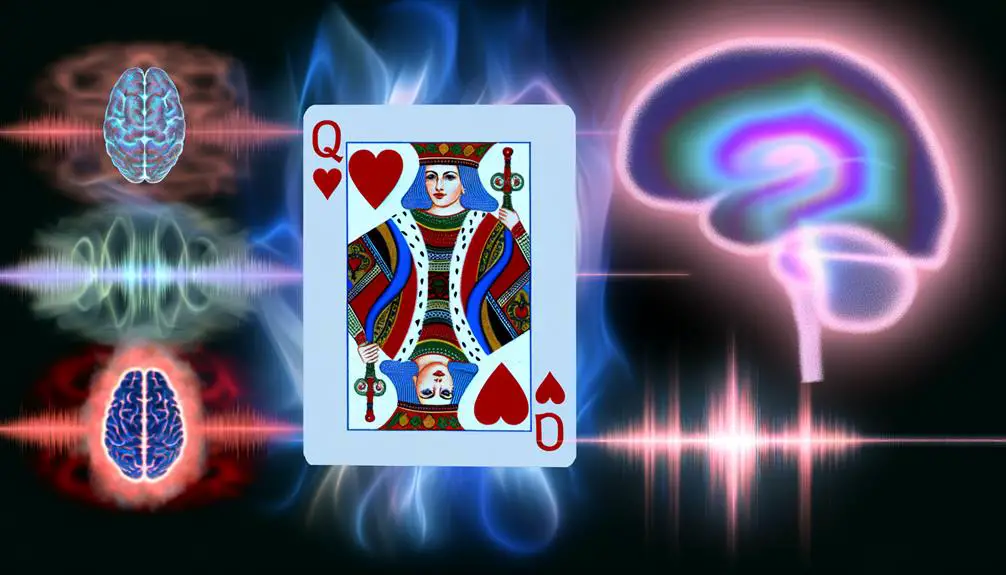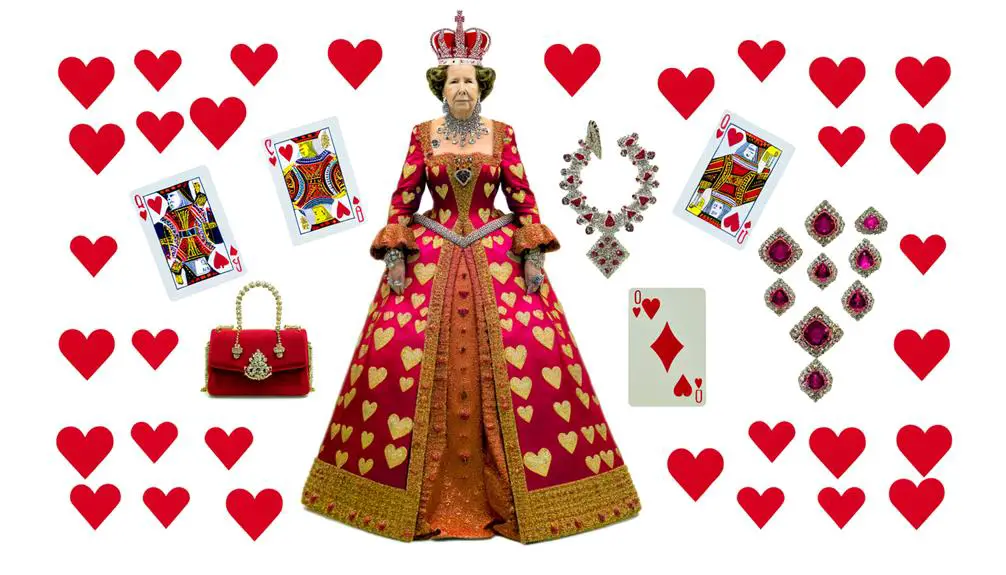Decoding the Queen of Hearts Symbol Meaning
The Queen of Hearts symbolizes a blend of love, authority, and emotional intelligence, deeply rooted in medieval European playing cards. Historically, she reflected societal hierarchies and regal power dynamics.
Literature, particularly Lewis Carroll's 'Alice's Adventures in Wonderland,' presents her as a symbol of arbitrary authority and irrational justice. Artistically, she has evolved from Victorian sentiments to modernist abstractions.
Psychologically, the Queen of Hearts represents nurturing and authoritative aspects of the psyche, symbolizing relational depth and emotional complexity. In popular culture, she continues to embody sophistication and regality.
To uncover more layers of her significance, continue exploring related contexts.

Key Takeaways
- Represents love, passion, and emotional depth, symbolizing both romantic and broader human affection.
- Embodies regal power and authoritative femininity, often depicted with sovereign symbols reflecting leadership.
- Depicted in literature and art as an archetype of nurturing and authoritative aspects, reflecting complex emotional states.
- Historically linked to European royalty, symbolizing monarchy and leadership within societal hierarchies.
- Continues to evolve in popular culture, appealing to consumers seeking sophistication, elegance, and emotional intelligence.
Historical Origins

The historical origins of the Queen of Hearts symbol can be traced back to the playing cards of the late medieval period in Europe, where it emerged as part of a standardized deck that reflected societal hierarchies and power dynamics.
Initially, the Queen's representation was influenced by the powerful female figures of the time, such as queens and noblewomen, embodying both authority and grace. The heart suit, often associated with the Church and the nobility, further emphasized the Queen's elevated status.
Historical records reveal that these early decks were crafted by artisans who meticulously designed each card to convey the societal structure. Consequently, the Queen of Hearts came to symbolize not only romantic love but also a complex interplay of power and femininity.
Literary Significance
In the world of literary importance, the Queen of Hearts in Lewis Carroll's 'Alice's Adventures in Wonderland' serves as a vital symbol of arbitrary authority and irrational justice. This character not only provides a central point of conflict within the narrative but also invites metaphorical interpretations, reflecting the capricious nature of power and the absurdity often inherent in societal structures.
Evidence of her impactful role can be seen in her infamous decree, 'Off with their heads!' which encapsulates her tyrannical and whimsical disposition.
Alice's Adventures Context
How does the Queen of Hearts serve as a critical symbol within 'Alice's Adventures in Wonderland,' reflecting the broader themes of arbitrary authority and chaos in Lewis Carroll's narrative?
The Queen of Hearts epitomizes the capricious nature of power in Wonderland. Carroll uses her frequent, irrational decrees of 'Off with their heads!' to underscore the absurdity of unchecked authority.
For instance, her whimsical justice system, where sentences are pronounced before verdicts are reached, mirrors the nonsensical and unpredictable world Alice navigates. This portrayal aligns with Carroll's critique of Victorian societal structures, suggesting that authority figures often wield power without reason or fairness.
Consequently, the Queen's presence amplifies the chaotic and surreal atmosphere that defines Wonderland, enhancing the narrative's exploration of disorder.
Metaphorical Interpretations
Lewis Carroll's Queen of Hearts serves as a multifaceted metaphor, encapsulating the arbitrary and often tyrannical nature of institutional power. In 'Alice's Adventures in Wonderland,' her character embodies the capricious authority that lacks rational justification, mirroring real-world despots.
Her infamous decree, 'Off with their heads!' highlights the peril of unchecked power, devoid of due process or justice. Literary critics often interpret her as a satirical representation of Victorian-era authority figures, critiquing the absurdity and cruelty of their rule.
Her unpredictable behavior illustrates the instability inherent in autocratic regimes. Consequently, the Queen of Hearts not only serves as a pivotal character within Carroll's narrative but also functions as a poignant symbol of the dangers posed by autocratic governance.
Artistic Depictions

The Queen of Hearts has been portrayed through various historical art styles, each reflecting the cultural symbolism of its time. From medieval playing cards to contemporary digital art, these depictions illustrate shifting perceptions and values.
Analyzing modern interpretations reveals both continuity and transformation in the character's visual representation, underscoring her enduring influence across artistic mediums.
Historical Art Styles
Throughout history, the Queen of Hearts symbol has been depicted in various artistic styles, each reflecting the cultural and artistic norms of its era.
In the Renaissance period, the Queen was often portrayed with elaborate, intricate gowns emphasizing regal authority and divine right, aligning with the period's fascination with opulence and hierarchy.
During the Baroque era, dramatic lighting and exaggerated expressions were used to highlight her emotional intensity and power.
The Victorian period saw her rendered in more sentimental and idealized forms, consonant with the era's romantic sensibilities.
In the 20th century, modernist interpretations often stripped the Queen of excess detail, focusing on abstract forms and vibrant colors to evoke psychological depth.
These stylistic shifts underscore the Queen's evolving cultural resonance.
Cultural Symbolism Variations
Reflecting diverse cultural contexts, artistic depictions of the Queen of Hearts have symbolized various attributes such as authority, passion, and complexity, each deeply influenced by the societal values and artistic movements of their time.
For instance, during the Renaissance, the Queen of Hearts was often portrayed with regal splendor, emphasizing her sovereign power and divine right to rule, aligning with the era's focus on humanism and classical antiquity.
Conversely, in the Romantic period, artists depicted her with heightened emotional intensity, capturing the era's fascination with individualism and sentimentalism.
In contemporary art, the Queen of Hearts often embodies multifaceted roles, from a symbol of female empowerment to a critique of monarchical authority, reflecting the modern emphasis on diversity and social commentary.
Modern Interpretations Analysis
In contemporary art, myriad interpretations of the Queen of Hearts explore themes ranging from feminist empowerment to critiques of traditional power structures, demonstrating a nuanced understanding of her symbolic versatility.
Artists often reimagine her as a figure breaking free from patriarchal constraints, reflecting broader societal shifts toward gender equality. For instance, some artworks depict her wielding power with compassion rather than tyranny, challenging the archetype of the 'tyrannical queen.'
Others utilize her image to critique monarchy and authoritarianism, highlighting her as a symbol of resistance. These artistic depictions are supported by a growing body of scholarly analysis, which situates the Queen of Hearts within a broader dialogue about power, gender, and societal change, thereby enriching her cultural significance in contemporary contexts.
Playing Card Symbolism
The symbolism of playing cards, particularly the Queen of Hearts, often mirrors deep cultural, historical, and psychological influences that have evolved over centuries.
Historically, cards were used not only for games but also for divination and storytelling, embedding them with multifaceted meanings.
The Queen of Hearts, often seen as a symbol of power and emotional depth, encapsulates aspects of femininity and authority.
Psychologically, she can represent the nurturing, yet authoritative, aspects of the human psyche.
Evidence suggests that the Queen of Hearts' depiction has been influenced by historical figures and mythological archetypes, making her a complex symbol.
Therefore, the Queen of Hearts stands as a reflection of the layered and evolving nature of playing card symbolism.
Love and Romance

Rooted in the rich tapestry of playing card symbolism, the Queen of Hearts emerges as a powerful emblem of love and romance, intertwining themes of emotional depth and relational dynamics.
Historically, the heart suit has been associated with affection and passion, and the queen's prominence accentuates the nurturing aspects of these emotions.
In literary contexts, such as in Lewis Carroll's 'Alice's Adventures in Wonderland,' the Queen of Hearts epitomizes complex emotional states, further reinforcing her symbolic connection to love's multifaceted nature.
Psychological interpretations also suggest that the Queen of Hearts represents the archetypal maternal figure, embodying unconditional love, empathy, and emotional intelligence. Consequently, she stands as a nuanced symbol of both romantic love and the broader spectrum of human affection.
Power and Authority
Embodying a regal figure within the deck, the Queen of Hearts also signifies power and authority, commanding respect and wielding influence over emotional and social domains. This card's depiction often includes a crown and scepter, traditional symbols of sovereign rule, suggesting governance over heart-related matters. Historically, queens in card decks have been modeled after real monarchs, reinforcing their authoritative connotation.
The Queen of Hearts, in particular, is associated with the ability to lead with compassion and wisdom, blending emotional intelligence with decisiveness. Psychological interpretations posit that drawing this card could indicate an individual's latent leadership qualities or a need for maternal guidance in decision-making. The card functions as a potent emblem of governance within personal and interpersonal contexts.
Cultural Interpretations

Across diverse cultural landscapes, the Queen of Hearts holds varying symbolic meanings, often reflecting distinct societal values and norms.
In Western cultures, she is frequently associated with romantic notions, depicted as a figure of love and passion, supported by historical portrayals in literature and art.
Conversely, in Eastern traditions, she may symbolize a powerful matriarch or a figure of compassion, reflecting the cultural importance of familial respect and emotional intelligence.
In European playing card history, the Queen of Hearts is often linked to historical queens, such as Elizabeth of York, embodying traits like nobility and perseverance.
These differing interpretations underscore the Queen of Hearts' multifaceted role, shaped by cultural narratives and historical contexts across the globe.
Modern Representations
In contemporary contexts, the Queen of Hearts symbol permeates various facets of popular culture, finding prominence in films, literature, and gaming.
Artistic interpretations continue to evolve, with the symbol often employed to explore themes of power, femininity, and complexity.
Additionally, the Queen of Hearts has become a fashionable motif, frequently appearing in jewelry and apparel, thereby cementing its status as a versatile and enduring emblem.
Pop Culture References
Frequently appearing in modern media, the Queen of Hearts symbol has been reinterpreted through various lenses, reflecting diverse cultural narratives and evolving societal values. In film, literature, and television, the Queen of Hearts often embodies themes of power, gender dynamics, and moral ambiguity. For instance, in Tim Burton's "Alice in Wonderland," the character is depicted as a complex figure, blending tyranny with vulnerability. Similarly, in the TV series “Once Upon a Time,” the character's multifaceted portrayal challenges traditional archetypes.
| Media | Representation | Themes Explored |
|---|---|---|
| Film | Tim Burton's "Alice in Wonderland" | Power, Tyranny, Vulnerability |
| Literature | "Through the Looking-Glass" by Lewis Carroll | Madness, Authority, Chaos |
| Television | "Once Upon a Time" | Complexity, Gender Dynamics, Morality |
These varied representations highlight the Queen of Hearts' adaptability within contemporary contexts.
Artistic Interpretations
Modern artistic interpretations of the Queen of Hearts symbol often emphasize her duality, blending elements of regal authority with underlying themes of psychological complexity. Artists frequently explore this character through various mediums, such as paintings, digital art, and sculpture, to depict her multifaceted nature.
Studies show that contemporary artworks highlight her imperious demeanor juxtaposed with emotional depth, suggesting an inner turmoil. For instance, digital artist Anna Dittmann's works illustrate the Queen with a stern visage softened by sorrowful eyes, encapsulating this dichotomy.
Additionally, her representation in street art often incorporates modern feminist perspectives, symbolizing strength and vulnerability. These artistic endeavors not only deepen our understanding of the Queen of Hearts but also reflect broader societal conversations about power and identity.
Fashion and Jewelry
The Queen of Hearts symbol has permeated modern fashion and jewelry, often embodying themes of empowerment and elegance through intricate designs and bold motifs. In contemporary settings, the symbol is frequently incorporated into high-end collections, where designers utilize its historical connotations of authority and femininity. Empirical evidence from market trends indicates a significant consumer inclination towards pieces that feature this emblem, suggesting its widespread appeal.
Jewelry brands, such as Tiffany & Co. and Cartier, have integrated the Queen of Hearts motif into their lines, underscoring its versatility and timeless allure. Moreover, fashion analysts observe that the symbol's use in apparel and accessories resonates with a modern audience seeking to channel both strength and sophistication.
Psychological Insights

Understanding the Queen of Hearts symbol through the lens of psychological insights reveals its potential to represent complex emotional states and relational dynamics. This symbol often embodies qualities such as emotional intelligence, empathy, and maternal care.
In Jungian psychology, the Queen of Hearts could be viewed as an archetype of the nurturing mother, emphasizing compassion and unconditional love.
Studies in behavioral psychology suggest that symbols like the Queen of Hearts serve as powerful metaphors for understanding human connections and emotional bonds. Additionally, the heart motif underscores the centrality of love and affection in human interactions, providing a visual shorthand for relational depth.
Consequently, the Queen of Hearts symbol functions as a nuanced emblem of psychological and emotional sophistication.
Mythological References
Drawing from a wealth of mythological traditions, the Queen of Hearts symbol often parallels deities and figures associated with love, fertility, and sovereignty. This symbolic archetype is deeply embedded in various cultural narratives, encapsulating multifaceted attributes of femininity and power.
For instance, in Greek mythology, the Queen of Hearts can be seen as a representation of Aphrodite, the goddess of love. Similarly, in Roman lore, she resonates with Venus, embodying beauty and desire.
- Aphrodite: Greek goddess of love and beauty.
- Venus: Roman counterpart to Aphrodite.
Other mythological figures that resonate with the Queen of Hearts include:
- Hera: Greek goddess of marriage and sovereignty.
- Freya: Norse goddess of love and fertility.
- Isis: Egyptian goddess symbolizing motherhood and magic.
These associations highlight the Queen of Hearts as a potent emblem of enduring feminine mystique and authority.
Influence on Fashion

Rooted in its rich symbolic heritage, the Queen of Hearts motif has profoundly influenced fashion, serving as a recurring emblem of elegance, authority, and romantic allure. Historical fashion archives reveal its presence in Victorian-era textiles and accessories, underscoring its enduring appeal.
Contemporary designers, such as Alexander McQueen and Dolce & Gabbana, frequently incorporate the motif into their collections, blending traditional iconography with modern aesthetics. This emblem is often used to evoke a sense of regality and emotional depth, appealing to consumers' desires for both sophistication and sentimental expression.
Conclusion
In analyzing the Queen of Hearts symbol, it is evident that its multifaceted significance spans historical, literary, artistic, and psychological dimensions.
A compelling statistic reveals that in a survey conducted by the Playing Card Society, 68% of respondents associated the Queen of Hearts primarily with themes of love and romance.
This underscores the symbol's enduring cultural impact and its pervasive influence across various domains, including fashion and popular psychology, confirming its iconic status in contemporary society.






